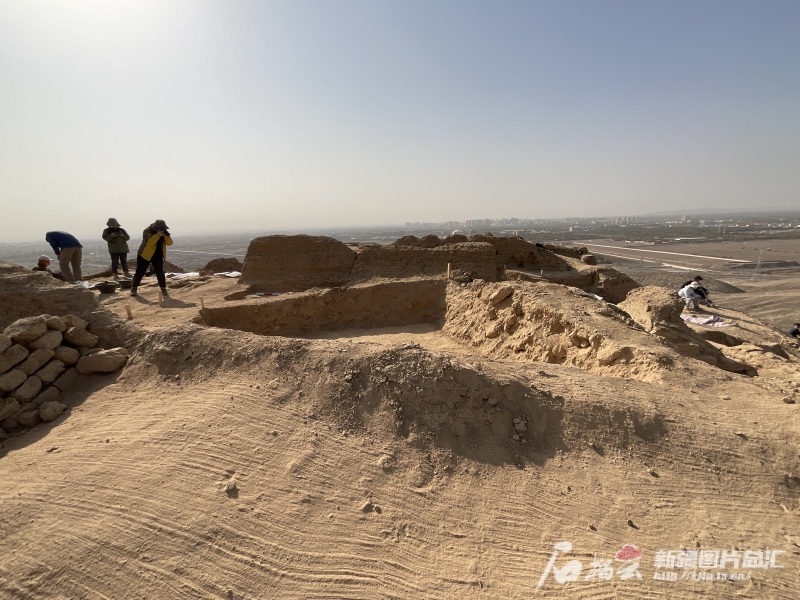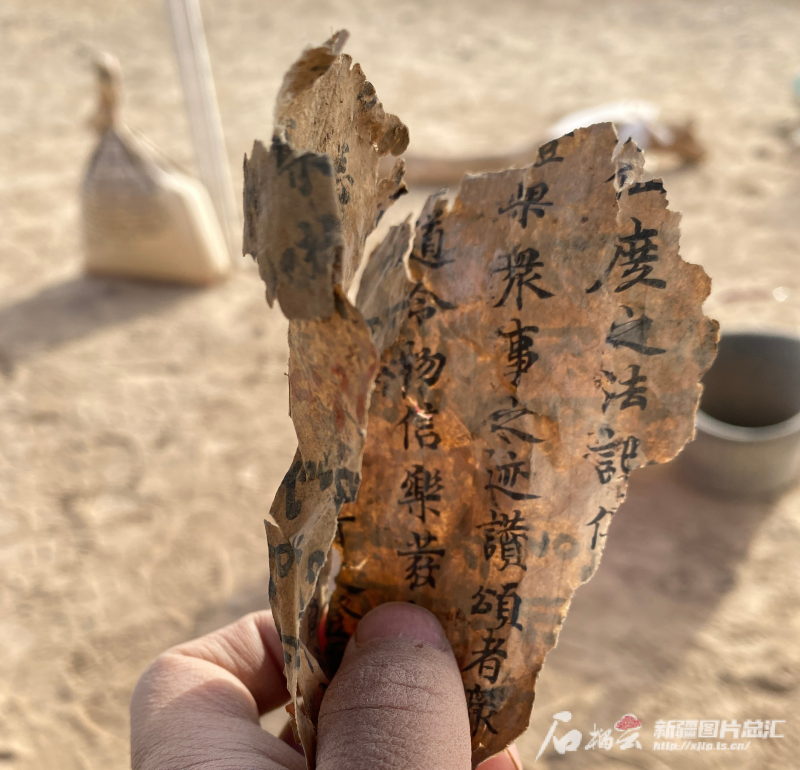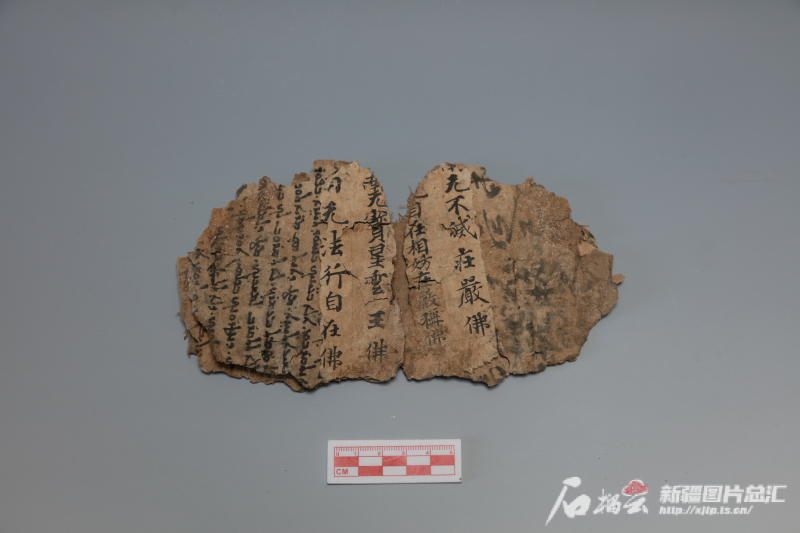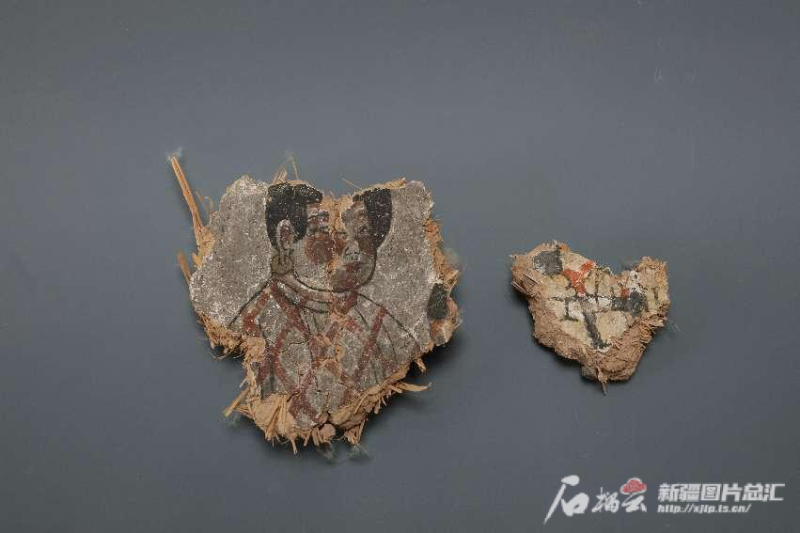
Aerial photo shows the Xipang Jingjiao monastery relics site. (Photo courtesy of the interviewees)
Shiliuyun-Xinjiang Daily (Reporter Zhao Mei) news: Where is “Xipang”? What is the history of this site where a large number of Nestorian documents have been unearthed?
Nearly a hundred years ago, an investigation report published by a German expedition brought the world’s attention to a Nestorian site called “Xipang Jingjiao monastery relics site” (“Jingjiao” is the ancient name of Nestorianism in China) in Turpan, Xinjiang. However, since the expedition didn’t record the location of the site, no one else knew where to find until the workers of Tupan Cultural Relics Bureau and Academia Turfanica strived to find the site in 2004.
Since 2021, Sun Yat-sen University, the Xinjiang Institute of Cultural Relics and Archaeology and Academia Turfanica have jointly had archaeological excavation to the Xipang relics site for two years, and the mystery of the site has finally been uncovered.
On January 30, 2024, the results of the "Archaeology Forum of Chinese Academy of Social Sciences -- Archaeological Discoveries of 2023" were announced in Beijing, and the Xipang Jingjiao monastery relics site dating back to the Tang (618-907) and Song (960-1279) Dynasties excavated in Turpan City of Xinjiang were included.

Aerial photo shows the Xipang Jingjiao monastery relics site. (Photo courtesy of the interviewees)
Over 89 years, the Xipang Jingjiao monastery relics site was rediscovered
From 1904 to 1905, a German expedition team discovered the Xipang Jingjiao monastery relics site that had been buried for over a thousand years.
The expedition team discovered the sites of two Nestorian monasteries during their investigation in Turpan. They found the one was located at the eastern suburb of the ancient Gaochang, and the other, which was located at the northern suburb of Gaochang District, Turpan City, was the Xipang Jingjiao monastery relics site, where the Germans described in the report as “Shuïpang” (which is homophonic to “Xipang”, “Shuifang” or “Shuipan” in Chinese) site.
They excavated and robbed over 1,000 Nestorian documents written in various languages, including Chinese, Syriac, Uighur, Sogdian, Middle Persian, etc. When these documents were later interpreted, they attracted great attention from the international academic community and the Christian Church. People found a large number of previously unknown contents in these documents, in addition to the Christian liturgical documents and other contents, there are medical documents, ancient Greek philosophical works, etc. Manuscripts with both Buddhist and Taoist texts in Chinese and Nestorian texts in Syriac had been unearthed there, too.

Archaeological excavation site of the Xipang Jingjiao monastery relics site. (Photo courtesy of the interviewees)
There is no doubt that this discovery provides important clues for the study of the historical development of Nestorianism and the exchange between Eastern and Western civilizations. However, according to the record, the Xipang relics site was located around Bīlayuq (situated about 10 km north of Turpan at the foothills of the Tianshan Mountains), but the exact location of the site was unknown.
In 2004, the workers of Turpan Cultural Relics Bureau and Academia Turfanica found a photo of the site from the photos taken by the German expedition in 1905, and inferred that the site could be around the Grape valley in Turpan.
In order to confirm that, in November of the year, the workers began to survey every mountain hill, starting from the Tao’er valley, which is located four kilometers west of the Grape valley. When they were surveying at a place between the Grape valley and the Tao’er valley, which is at the southern foot of the west end of the Flaming Mountains, a knoll that stretches south and is next to a hill caught their attention. The knoll is very similar to the Xipang relics site in the photo. The workers rushed to take the photo and compare it with the site carefully, and finally confirmed the location of the Xipang Jingjiao monastery relics site.

Archaeological excavation site of the Xipang Jingjiao monastery relics site. (Photo courtesy of the interviewees)
Archaeological excavation reconstructs the flourishment of Nestorianism
In 2021, Sun Yat-sen University and Xinjiang University launched a scientific research plan to jointly build a key laboratory of "Sustainable Development of Historical and Cultural Tourism Resources in Xinjiang", and Xipang Jingjiao monastery relics site was included in the archaeological excavation plan.
During the years from 2001 to 2023, Sun Yat-sen University, Xinjiang Institute of Cultural Relics and Archaeology and Xinjiang Academia Turfanica jointly carried out archaeological excavations for nearly two years, and the mystery of the relics site was finally uncovered.
According to Liu Wensuo, a professor at the school of Sociology and Anthropology of Sun Yat-sen University and the leader of the archaeological excavation team of the Xipang Jingjiao monastery relics site, the site covers an area of 2,000 square meters, having two parts, namely the slope and the top of the knoll. When excavating a main part of the site, the archaeologists found a relatively complete structure with good preservation of a Nestorian monastery. The monastery is composed of three east-west buildings and outbuildings facing north and south side by side, and in addition to Nestorian ritual buildings, there are kitchens, cellars, bedrooms and other living areas. Comprehensive carbon-14 dating data and related relics suggest that the monastery could be traced back from the Tang Dynasty to Yuan Dynasty (1271-1368).

A fragment of Taoism sutra unearthed in the Xipang Jingjiao monastery relics site. (Photo courtesy of the interviewees)
Archaeological workers found that the overall layout of the site conforms to the typical “three-temple church” layout of Nestorian churches in West Asia and Central Asia, and its construction technology, materials, etc., show local traditional styles, while its brackets and other traditional construction techniques were from the Central Plains. “It indicates that the Nestorianism had been integrated with local culture after it was introduced in Turpan.”
A large number of important cultural relics with various kinds have been unearthed at the site, including 876 documents written in Chinese, ancient Syriac, Uighur, Sogdian and other languages, and a large number of mural fragments, lacquer bowls and “Xining Yuanbao” coins (“Xining” is the 1st era of the Emperor Shenzong of the Song Dynasty, 1068-1077, and a “Yuanbao” is a small metal ingot that was used in ancient China as money) from the Central Plains in the Northern Song Dynasty, and well-preserved jade crosses. Archaeologists also found manuscripts including Buddhist and Taoist sutra texts in Chinese and Nestorian texts in Syriac, and that the mural fragments are similar to the local mural paintings of the same period in style, painting techniques and use of pigments.
Liu said, the excavation of the site indicates that Nestorianism was once flourished in Turpan, and its classics have been translated into many languages, and the culture of Nestorianism had been well preserved. Nestorianism, Buddhism, Taoism and Manichaeism once lived in harmony, a manifestation of interactions, exchanges and integration of multiple cultures. “These archaeological discoveries are of great significance to the study of the historical development of Christianity, the archaeology of Nestorianism, the ancient languages and writings of the Western Regions and Christian literature, especially to the exchanges between Eastern and Western civilizations, and the inclusiveness and openness of Chinese civilization.”

A mural fragment unearthed at the Xipang Jingjiao monastery relics site. (Photo courtesy of the interviewees)
Witnessing the exchange between the Eastern and Western cultures
What is Nestorianism? How was Nestorianism preached in Xinjiang?
Nestorianism, a branch of Christianity, was introduced into China from Persia during the Tang Dynasty. Jingjiao was referred to as “Zoroastrianism” or “Qinjiao” (some Asian countries where Jingjiao originated or flourished were called “Da Qin” in ancient China), and “Jingjiao” was the name given to it after its introduction in the Tang Dynasty

Calligraphy sheets of a cloth-wrapped document unearthed at the Xipan Jingjiao monastery relics site. (Photo courtesy of the interviewees)
“Stele of Flourishment of Roman Nestorian Church in China” collected at the Xi`an Beilin Museum in Shannxi Province, northwest China, is one of China’s national treasures and considered by scholars to be the record that Nestorianism was introduced in China for the first time. According to the stele, in the ninth year (635) of the Tang Dynasty’s Zhenguan Period (627-649), a Nestorian “man of great virtue” (the title for a bishop) named Alopen arrived in Chang`an City, the capital of the Tang Dynasty, and the Emperor Taizong sent Prime Minister Fang Xuanling, to lead the honor guards to welcome him at the western suburb of the city. In the 12th year of Zhenguan Period, Emperor Taizong allowed him to preach Nestorianism, and established a Nestorian monastery, which was also called “Da Qin monastery” at the Yining Fang in Chang`an City. Since then, the Nestorianism started to be preached in the Central Plains.
Xinjiang has been at the crossroads of the Silk Road since the ancient time, so when the religion was introduced to ancient Xinjiang’s Shule, Khotan, Qiuci, Gaochang and other places, it could be assumed that the religion was preached to surrounding areas by taking Xinjiang as a transit point.

Photo shows fragments with Tang Dynasty’s style unearthed at the Xipang Jingjiao monastery relics site. (Photo courtesy of the interviewees)
From the Tang Dynasty to Yuan Dynasty, Nestorianism was preached in three areas of Xinjiang, which was Tupan, Kashi and Yili. Turpan’s Xipang Jingjiao monastery relics site was one of the Nestorian sites during that time.
“The archaeological excavation of the Xipang Jingjiao monastery relics site reflects exchanges and interactions of different cultures, sinicization of religion, etc., which deeply show the uniqueness of opening and inclusive Chinese culture and the mind of China embracing world civilizations.” Liu Wensuo said.
(A written permission shall be obtained for reprinting, excerpting, copying and mirroring of the contents published on this website. Unauthorized aforementioned act shall be deemed an infringement, of which the actor shall be held accountable under the law.)









